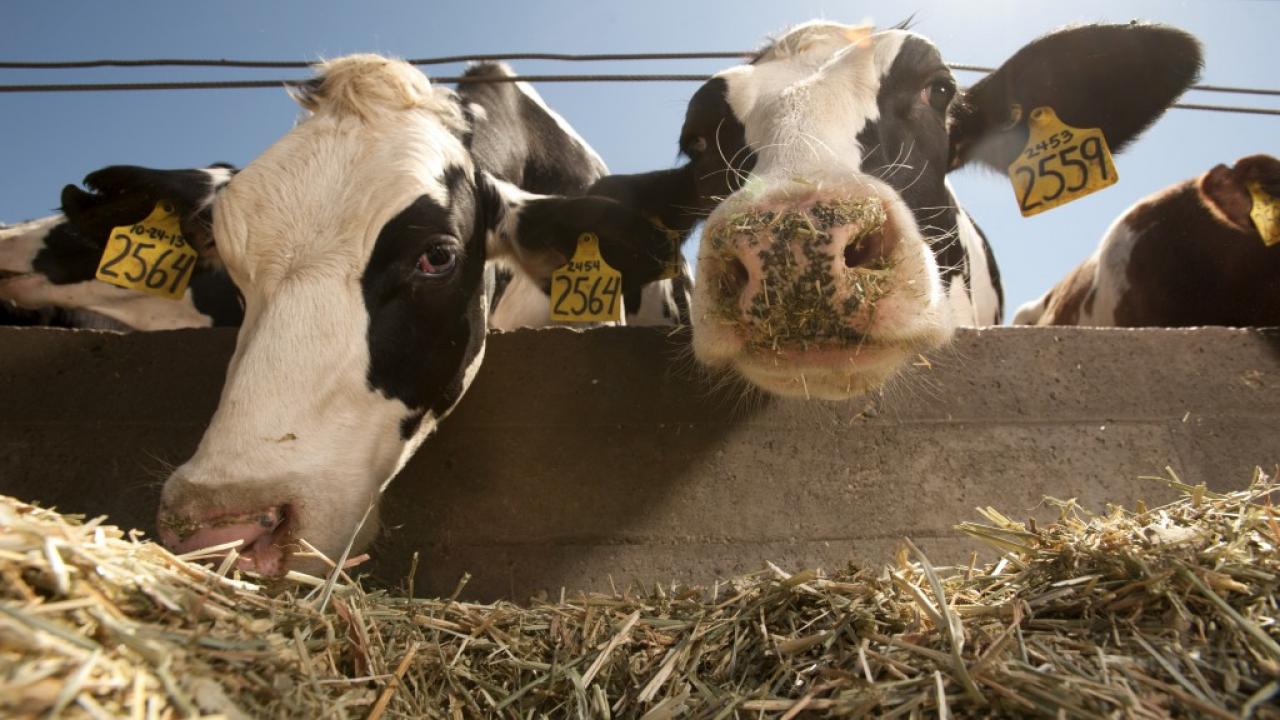
Working together to help agriculture manage nitrogen
Research supports productivity and environmental health
Nitrogen is important for producing high-yield crops, and productive agriculture is vital to feeding billions of people worldwide. But as a newly released nitrogen assessment shows,excess nutrients can pollute air and drinking water, and cause serious health and environmental risks.
That’s why UC Davis researchers are helping California farmers find the right rate, amount, and application of nitrogen to support productivity and environmental health. Here’s a look at new developments in agriculture that are already improving nitrogen-use efficiency throughout the state.
Providing fertilization guidelines
Applying the right amount of nitrogen is a challenge. Crops suffer if they don’t get enough nitrogen, but they can only absorb so much. The excess can leach into water systems or volatize into the air. Every crop has different nutrient needs, and even those requirements vary based on a long list of factors, such as soil type, weather, irrigation, and how much nitrogen from soil organic matter and other organic sources crops can access.
To remove some of the guesswork, Daniel Geisseler, Cooperative Extension specialist with land, air, and water resources, has created online nutrient-management guidelines for many California crops, from alfalfa to walnuts.
Professor Patrick Brown in the department of plant sciences has developed a nutrient calculator for almonds based on yield history, current conditions, and previous nitrogen applications.
On the UC Davis Fruit and Nut Research and Information Center site, farmers can find nitrogen prediction models for almond and pistachio.
Michael Cahn, Cooperative Extension farm advisor in Monterey County, developed an online tool called CropManage that helps farmers calculate water and nutrient needs for cool-weather crops like lettuce. Geisseler is working to expand the tool to include data for hot-weather crops like tomatoes.
A wealth of nitrogen-management resources is also available at the Solution Center for Nutrient Management.
Improving irrigation
Over the past decade, more farmers have switched from furrow irrigation to subsurface drip irrigation, which reduces water use, nutrient runoff, and greenhouse gas emissions. Professor Will Horwath with land, air, and water resources has shown that drip irrigation can produce 50 to 80 percent greater tomato yields with the same amount of water and nitrogen fertilizer, and also reduce nitrous oxide emissions by up to 50 percent. Today, more than 90 percent of tomato growers use drip irrigation.
Researchers are finding that drip irrigation can provide similar yield and environmental benefits with corn, lettuce, and other crops.
UC Davis researchers like Professor Shrini Upadhyaya with agricultural and biological engineering continue to improve drip and other precision-irrigation systems in fields, orchards, and vineyards across the state.
Assisting dairy and livestock industry
One in 10 people living in California’s most productive agricultural areas is at risk of nitrate contamination in their drinking water, according to a study co-authored by Thomas Harter, Cooperative Extension hydrologist with land, air, and water resources. The report found that agricultural fertilizers and animal manure applied to cropland are the two largest regional sources of groundwater contamination. The report also details dozens of water and nutrient management practices that can increase agricultural productivity and reduce groundwater nitrate loading.
Since the report’s release in 2012, Harter and his team have met with hundreds of policy-makers, farmers, dairy operators, and other agriculture leaders to address the issue, suggest solutions, and discuss funding mechanisms.
Deanne Meyer, Cooperative Extension specialist with the department of animal science, leads a team of researchers, specialists, and farm advisors that helps dairy operators comply with stringent waste discharge requirements adopted by the California Regional Water Quality Control Board, Central Valley Region, in 2007. Meyer studies the flow of nutrients into and out of dairies, helping farmers choose the most affective, cost-efficient feed and treatment technologies.
Professor Frank Mitloehner, air quality Extension specialist in the department of animal sciences, works to reduce greenhouse emissions from meat production and separate fact from fiction regarding livestock and climate change. As scientific lead for the North American section of the Global Feed Life Cycle Assessment Institute, Mitloehner is helping build a comprehensive database on all relevant variables and develop a tool to assess the feed industry's environmental footprint.
Cultivating healthy soil
The more fertile the soil, the fewer nutrients you need to add. UC Davis researchers like Professor Horwath and Tim Hartz, agronomy specialist with plant sciences, are helping growers enhance and measure soil fertility.
For example: Crops can access nitrogen from the mineralization (or breakdown) of organic material built up from years of cover crops, compost, and crop residue. Lab tests can tell how much organic nitrogen is in the soil, but don’t measure the microbial community responsible for how fast the organic nitrogen will become available to the crop. UC Davis researchers are studying whether carbon dioxide levels coming from soil can predict the speed of mineralization—an important clue for nutrient management.
Horwath and his team are also showing that practices which increase soil aeration, reduce compactions, and enhance soil structure with organic matter could decrease nitrous oxide emissions from agriculture land.
A Sacramento company that turns food waste into liquid fertilizer has launched a three-year almond trial at UC Davis to test the product’s effect on crop production, nitrogen leaching, and soil health. Working with Professor Ed Lewis with the department of entomology and nematology, California Safe Soil is also conducting ongoing trials with several other commodities, including berries, lettuce, and tomatoes. Results indicate the product can cut nitrogen use in half.
Professor Kate Scow with land, air, and water resources is director of Russell Ranch Sustainable Agriculture Facility where she and her fellow scientists work to make agriculture both productive and environmentally sound. Nitrogen-use efficiency was the focus at a recent field day.
You can find more information on the California Nitrogen Assessment from this UC Davis News Service press release.